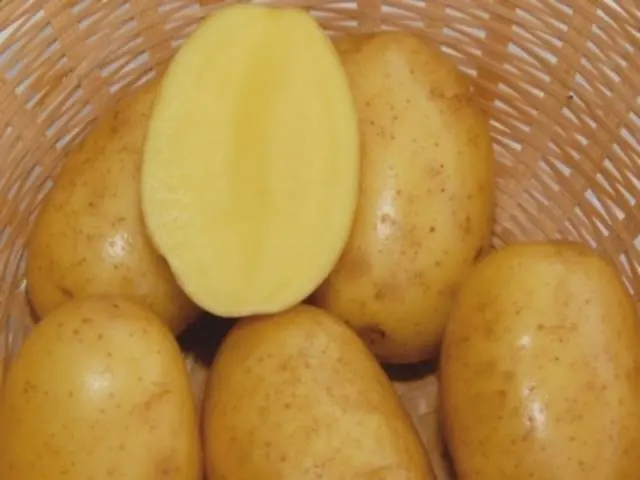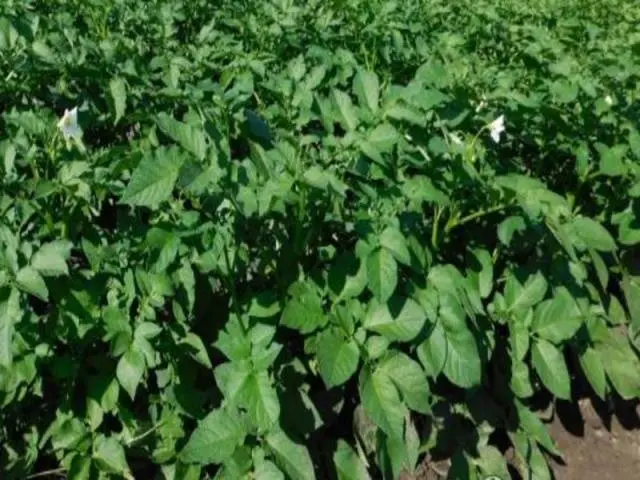Contents
Early varieties of potatoes will always be in demand. Gardeners grow them for themselves and for sale. A worthy representative of this class is the Vega variety, which stands out for its excellent taste and high yields.
Main characteristics
Bushes grow medium in size, are erect or semi-erect. The leaves of Vega potatoes are simple, with a dark green color and a wavy or slightly wavy edge. The bush is distinguished by medium foliage. Large flowers of whitish-cream shades are collected in corollas.
Approximately 7-9 large Vega potatoes ripen in each bush. The tuber is formed of medium size, roundish-oval shape, weighing 85-100 g. It is pleasant that the potato ripens, as a rule, even and neat, as in the photo.

The tubers are distinguished by a thin yellow skin without spots. The eyes are few, shallow and small. According to summer residents, Vega potatoes have a pleasant taste, the structure is not watery and moderately dry. Starch indicators – 10-16%.
Vega potatoes belong to medium-early table varieties. The growing season is 60-69 days. The vegetable is perfectly stored, the keeping quality index is quite high – almost 99%. Excellent transport over long distances.
An important advantage of the Vega variety is its excellent yield. The average figure is 230-375 centners per hectare.
The Vega variety has proven itself well and is now grown in Belarus, Ukraine and Our Country.
Peculiarities of growing
Vega potatoes do not require special attention when growing and tolerate small changes in temperature or humidity quite tolerably. Good yields are observed when planting potatoes on light sandy soils.
Rules of landing
It is advisable to carry out preliminary preparation of tubers for planting – germinate or warm. For planting, healthy, even tubers are selected, with no signs of disease. It is not recommended to plant tubers of irregular shape or uncharacteristic for the variety. Vega potatoes are placed in boxes or on racks in layers of two or three tubers. Containers or racks are installed in a bright, heated room with an air temperature of at least 15-17˚ C. To ensure uniform germination, it is necessary to rearrange the containers periodically.
Good sprouts on tubers appear after 21-23 days. To harden the planting material, it is recommended to carry out a sharp decrease in temperature several times – by about 6-8˚ C. Such actions will activate the growth of more eyes. Hardening of tubers will serve as a guarantee of friendly germination of planting material and a bountiful harvest. Before planting, tubers without sprouts or with thin filamentous sprouts are necessarily rejected. It is also undesirable to plant medium-sized potatoes weighing less than 30 g, as this will reduce the yield.
Holes in a row are formed in increments of 35-38 cm, and strips with a width of approximately 70-75 cm are left for row spacing.
During the season, it is desirable to spud the bushes at least twice. Weeding is carried out regularly. Weeds can be controlled manually or with herbicides.
Fertilizer and watering potatoes
Vega potatoes are very sensitive to watering. It is recommended to carry out infrequent, but abundant soil moisture. To obtain good yields, the soil must be saturated with water by at least 40-45 cm. The best irrigation option is drip irrigation, in which water will flow directly into the tubers, which will positively affect the yield.

During the season, it is recommended to fertilize the plant at least twice. During the period of leaf growth and tuber formation, it is desirable to use urea or ammonium nitrate. The second time, superphosphate or potassium sulfate is used. Mineral top dressing is applied after the flowering of potatoes and before the tops wither.
After the stems and foliage have completely dried, you can start digging the crop. Vega potatoes have a thin but strong skin that reliably protects the tubers from damage during digging.
The harvested crop must be left to dry.
It is also not recommended to leave the crop on the field overnight. Otherwise, sudden night or morning frosts can freeze Vega tubers.
When harvesting, it is important to carefully inspect the tubers and immediately discard cut, damaged vegetables with hints of rot. After drying, the tubers should be carefully collected in buckets to minimize damage to the potatoes. It is also advisable to calmly pour the potatoes into bags.
It is better to store potatoes in containers with a volume of about one and a half to two buckets. The best option is to knock down boxes from wooden slats. It is more convenient to store Vega potatoes in boxes for a number of reasons:
- the tubers lie in an even layer, and therefore no foci of “fogging” are formed;
- when wet rot appears, the affected fruits can be easily removed, and the spread of rot will be limited to the outside of the box;
- potatoes are practically not injured;
- it is more convenient to quickly check the condition of the tubers.

Vega seed potatoes can be harvested by yourself. To do this, it is necessary to mark the most promising bushes in the middle of the season. For subsequent planting, even tubers are selected, without damage, diseases and not cut during digging. It is better to store Vega seed in a separate box, which is desirable to sign so as not to be confused with other containers.
Diseases and pests
Vega potatoes are considered resistant to viral diseases, common scab, potato cancer and tobacco mosaic.
Since Vega potatoes ripen early, the tubers and leaves are practically not damaged by late blight. As a preventive measure, it is recommended to treat the bushes with copper-containing compounds (copper sulfate, Bordeaux mixture).
With the appearance of Colorado beetles, it is possible to use different means of control. Insects are picked by hand or Vega bushes are sprayed with chemicals (Regent, Sonnet, Karate). Some gardeners advise the use of plant infusions (acacia, celandine), dusting with ash.
As a general preventive measure, it is worth preparing the soil: the remains of plants are carefully removed from the surface, the soil is irrigated with antifungal agents (Bordeaux liquid, copper sulfate solution) and dug up.
There is a possibility of damage to the tubers by wireworms – these are the larvae of click beetles. To combat the pest, when planting Vega potatoes, put 3-4 superphosphate granules sprayed with insecticide (Aktellik, Karate) in each well. As a preventive natural method, sowing of special plants (mustard, alfalfa) is carried out. It is also recommended to observe crop rotation – planting potatoes after cabbage and root crops.
Vega potatoes are a versatile variety, as a tasty vegetable suitable for dietary and baby food. Growing potatoes will not cause difficulties even for beginner gardeners.









